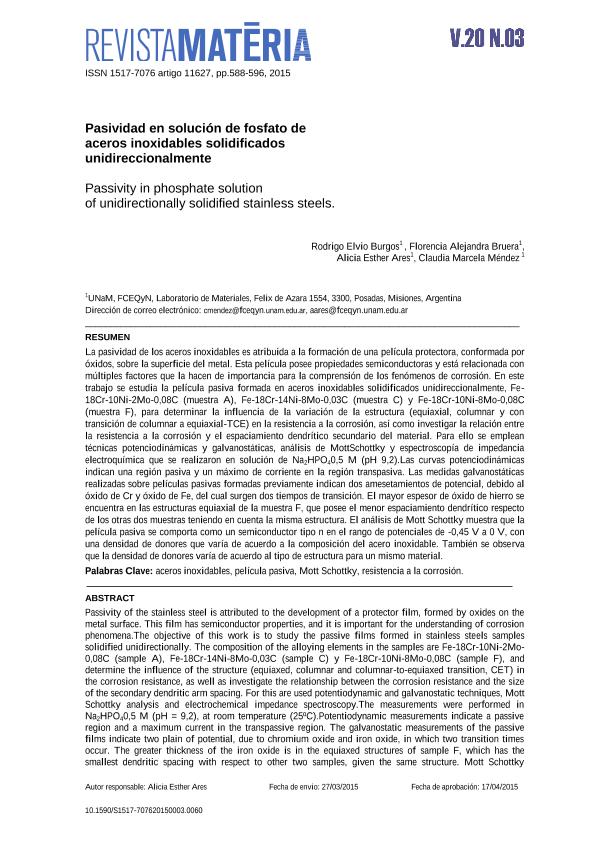Mostrar el registro sencillo del ítem
dc.contributor.author
Burgos, Rodrigo Elvio
dc.contributor.author
Bruera, Florencia Alejandra

dc.contributor.author
Ares, Alicia Esther

dc.contributor.author
Mendez, Claudia Marcela
dc.date.available
2016-12-19T14:52:49Z
dc.date.issued
2015-09
dc.identifier.citation
Burgos, Rodrigo Elvio; Bruera, Florencia Alejandra; Ares, Alicia Esther; Mendez, Claudia Marcela; Pasividad en solución de fosfato de aceros inoxidables solidificados unidireccionalmente; Univ Fed Rio de Janeiro; Revista Matéria; 20; 3; 9-2015; 588-596
dc.identifier.issn
1517-7076
dc.identifier.uri
http://hdl.handle.net/11336/9701
dc.description.abstract
Passivity of the stainless steel is attributed to the development of a protector film, formed by oxides on the metal surface. This film has semiconductor properties, and it is important for the understanding of corrosion phenomena.The objective of this work is to study the passive films formed in stainless steels samples solidified unidirectionally. The composition of the alloying elements in the samples are Fe-18Cr-10Ni-2Mo- 0,08C (sample A), Fe-18Cr-14Ni-8Mo-0,03C (sample C) y Fe-18Cr-10Ni-8Mo-0,08C (sample F), and determine the influence of the structure (equiaxed, columnar and columnar-to-equiaxed transition, CET) in the corrosion resistance, as well as investigate the relationship between the corrosion resistance and the size of the secondary dendritic arm spacing. For this are used potentiodynamic and galvanostatic techniques, Mott Schottky analysis and electrochemical impedance spectroscopy.The measurements were performed in Na2HPO40,5 M (pH = 9,2), at room temperature (25ºC).Potentiodynamic measurements indicate a passive region and a maximum current in the transpassive region. The galvanostatic measurements of the passive films indicate two plain of potential, due to chromium oxide and iron oxide, in which two transition times occur. The greater thickness of the iron oxide is in the equiaxed structures of sample F, which has the smallest dendritic spacing with respect to other two samples, given the same structure. Mott Schottky analysis shows that the passive film behaves as an n-type semiconductor in the potential range of -0.45 V to 0 V, with a density of-donor that varies according to the composition of stainless steel. It is also observed that the density-donor varies according to the type of structure for the same material.
dc.description.abstract
Passivity of the stainless steel is attributed to the development of a protector film, formed by oxides on the metal surface. This film has semiconductor properties, and it is important for the understanding of corrosion phenomena.The objective of this work is to study the passive films formed in stainless steels samples solidified unidirectionally. The composition of the alloying elements in the samples are Fe-18Cr-10Ni-2Mo-0,08C (sample A), Fe-18Cr-14Ni-8Mo-0,03C (sample C) y Fe-18Cr-10Ni-8Mo-0,08C (sample F), and determine the influence of the structure (equiaxed, columnar and columnar-to-equiaxed transition, CET) in the corrosion resistance, as well as investigate the relationship between the corrosion resistance and the size of the secondary dendritic arm spacing. For this are used potentiodynamic and galvanostatic techniques, Mott Schottky analysis and electrochemical impedance spectroscopy.The measurements were performed in Na2HPO40,5 M (pH = 9,2), at room temperature (25ºC).Potentiodynamic measurements indicate a passive region and a maximum current in the transpassive region. The galvanostatic measurements of the passive films indicate two plain of potential, due to chromium oxide and iron oxide, in which two transition times occur. The greater thickness of the iron oxide is in the equiaxed structures of sample F, which has the smallest dendritic spacing with respect to other two samples, given the same structure. Mott Schottky analysis shows that the passive film behaves as an n-type semiconductor in the potential range of -0.45 V to 0 V, with a density of-donor that varies according to the composition of stainless steel. It is also observed that the density-donor varies according to the type of structure for the same material.
dc.format
application/pdf
dc.language.iso
spa
dc.publisher
Univ Fed Rio de Janeiro

dc.rights
info:eu-repo/semantics/openAccess
dc.rights.uri
https://creativecommons.org/licenses/by-nc-sa/2.5/ar/
dc.subject
Aceros Inoxidables
dc.subject
Película Pasiva
dc.subject
Mott Schottky
dc.subject
Resistencia a La Corrosión
dc.subject.classification
Ingeniería de los Materiales

dc.subject.classification
Ingeniería de los Materiales

dc.subject.classification
INGENIERÍAS Y TECNOLOGÍAS

dc.title
Pasividad en solución de fosfato de aceros inoxidables solidificados unidireccionalmente
dc.title
Passivity in phosphate solution of unidirectionally solidified stainless steels
dc.type
info:eu-repo/semantics/article
dc.type
info:ar-repo/semantics/artículo
dc.type
info:eu-repo/semantics/publishedVersion
dc.date.updated
2016-12-16T17:55:22Z
dc.journal.volume
20
dc.journal.number
3
dc.journal.pagination
588-596
dc.journal.pais
Brasil

dc.journal.ciudad
Rio de Janeiro
dc.description.fil
Fil: Burgos, Rodrigo Elvio. Universidad Nacional de Misiones; Argentina
dc.description.fil
Fil: Bruera, Florencia Alejandra. Universidad Nacional de Misiones; Argentina. Consejo Nacional de Investigaciones Científicas y Técnicas; Argentina
dc.description.fil
Fil: Ares, Alicia Esther. Consejo Nacional de Investigaciones Cientificas y Tecnicas. Centro Cientifico Tecnológico Nordeste. Instituto de Materiales de Misiones; Argentina
dc.description.fil
Fil: Mendez, Claudia Marcela. Universidad Nacional de Misiones; Argentina
dc.journal.title
Revista Matéria

dc.relation.alternativeid
info:eu-repo/semantics/altIdentifier/url/http://ref.scielo.org/qbcbzh
dc.relation.alternativeid
info:eu-repo/semantics/altIdentifier/doi/http://dx.doi.org/10.1590/S1517-707620150003.0060
Archivos asociados
